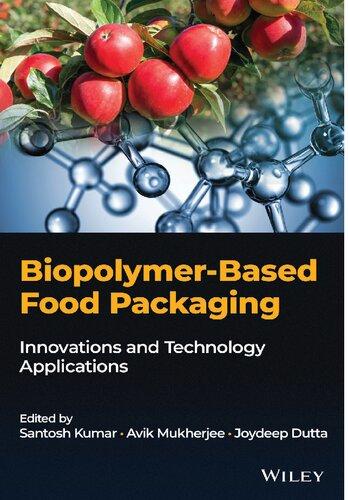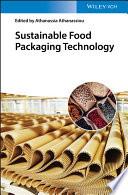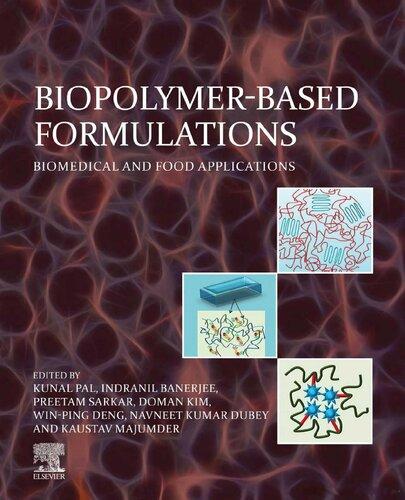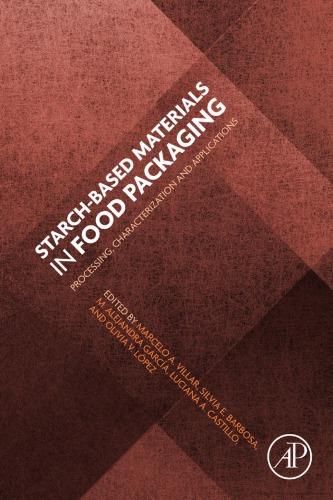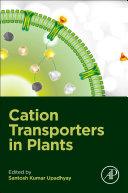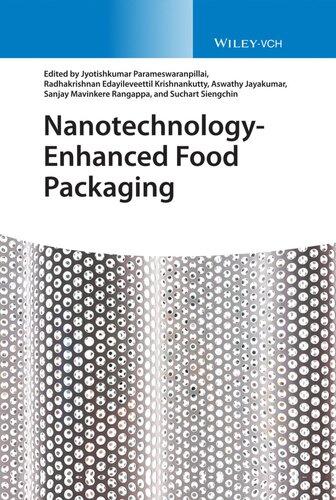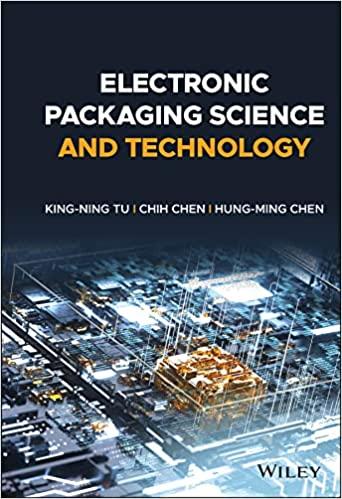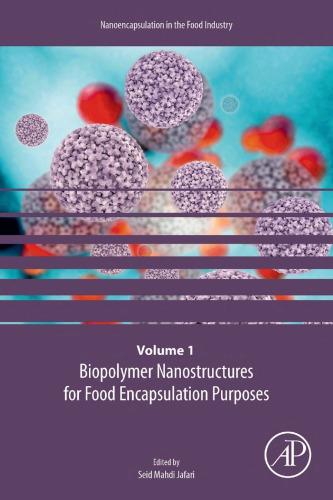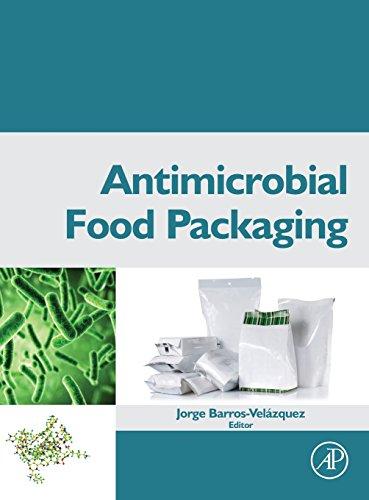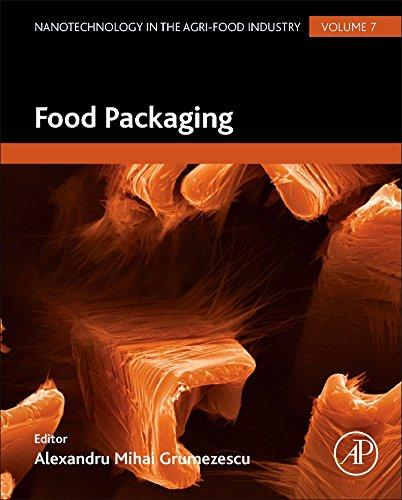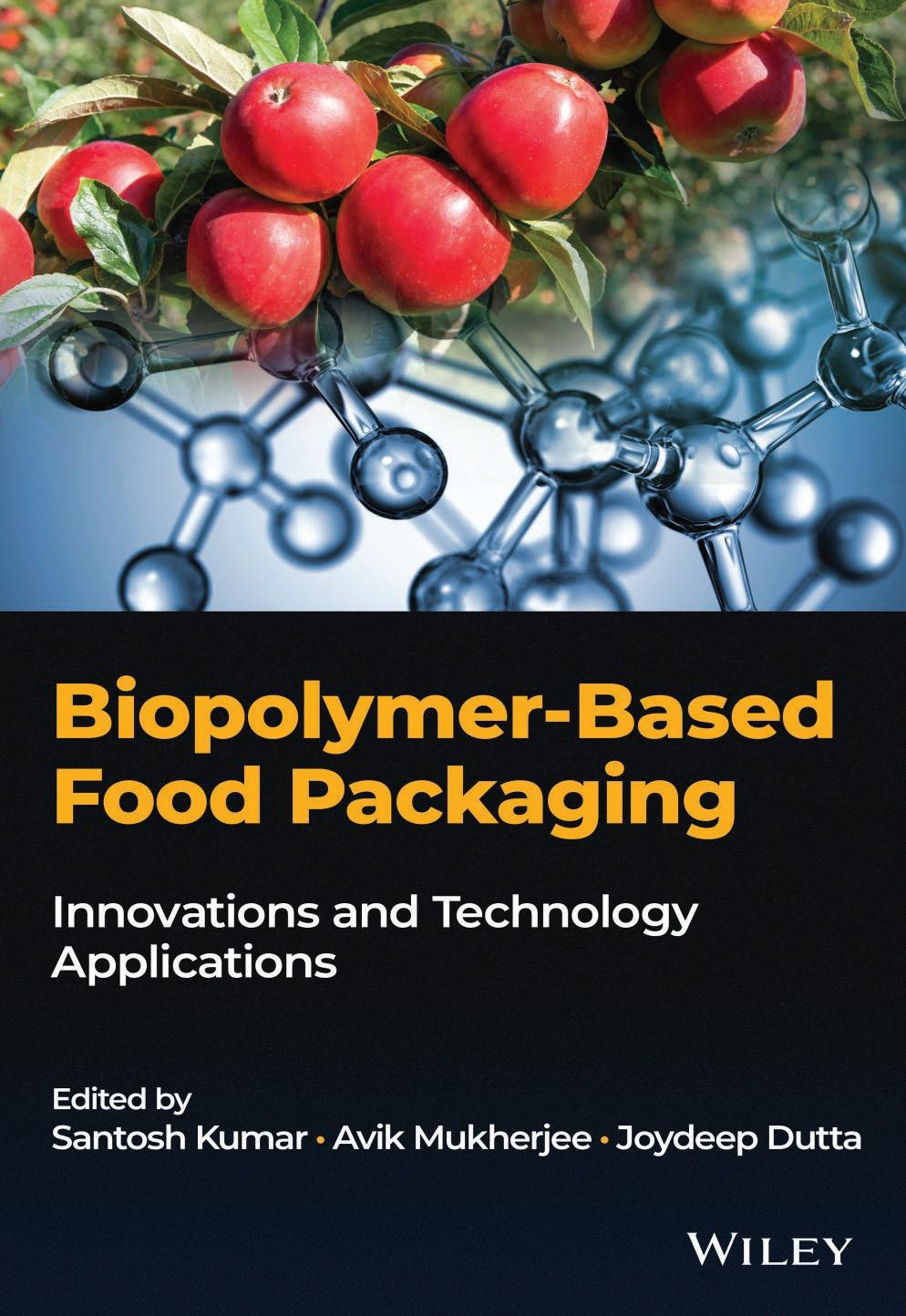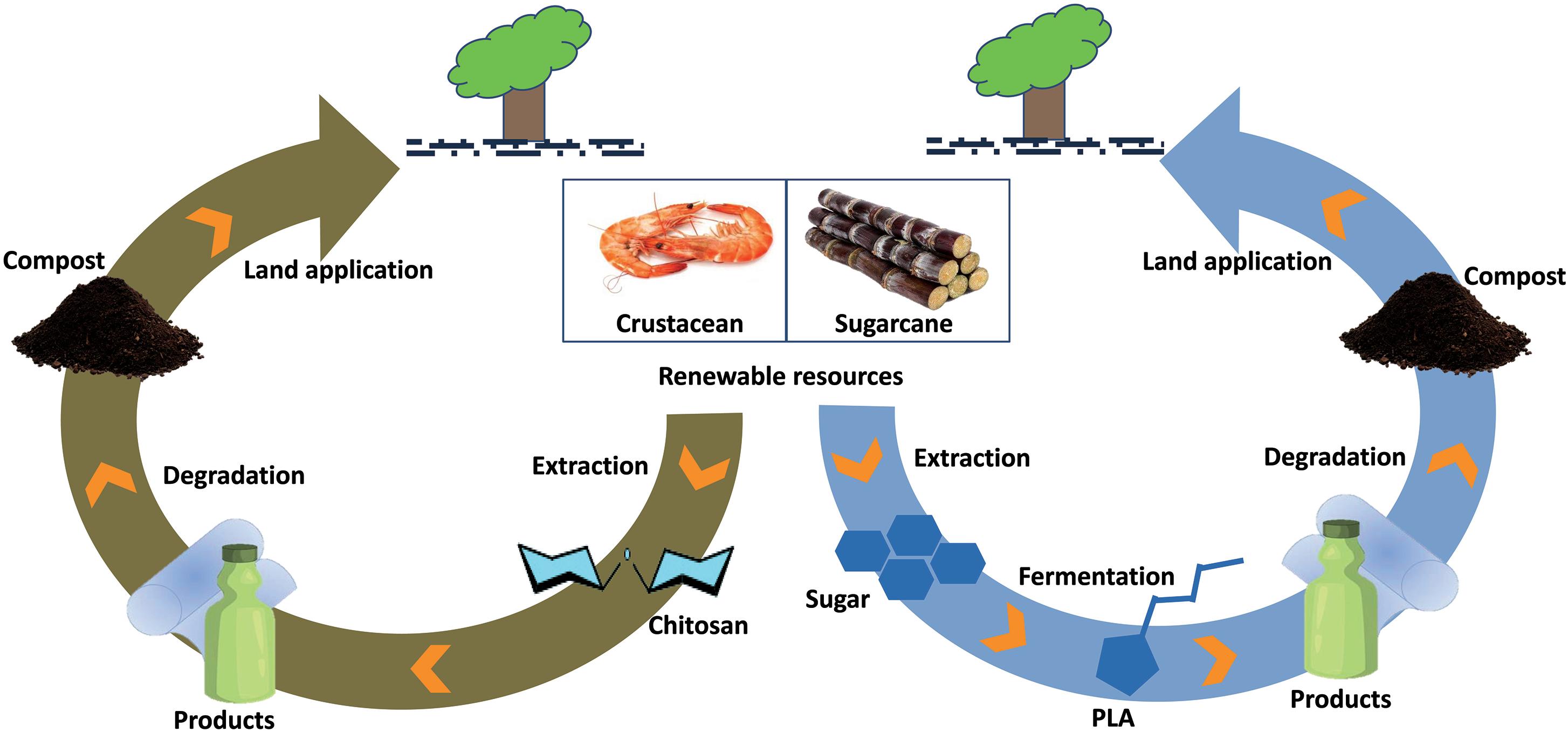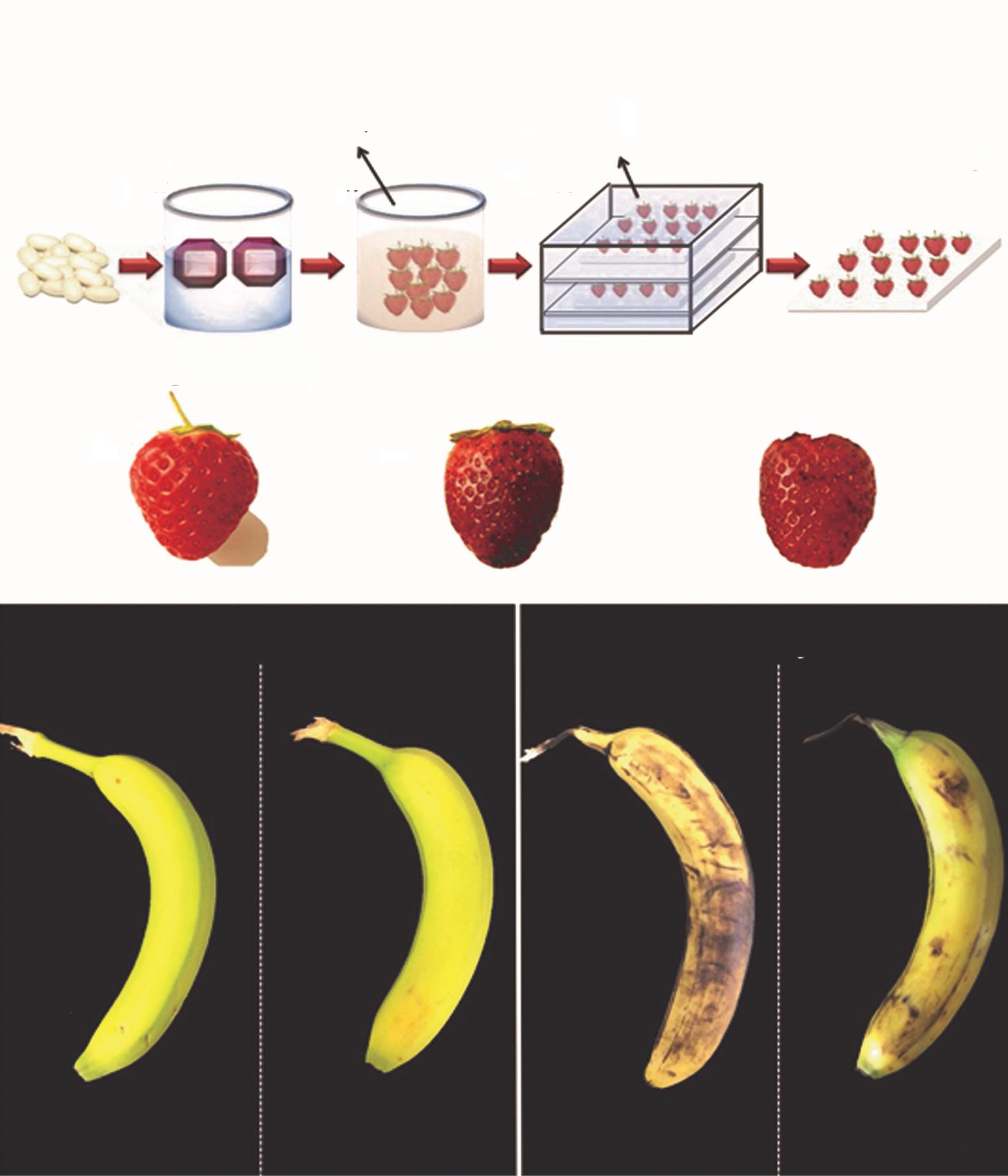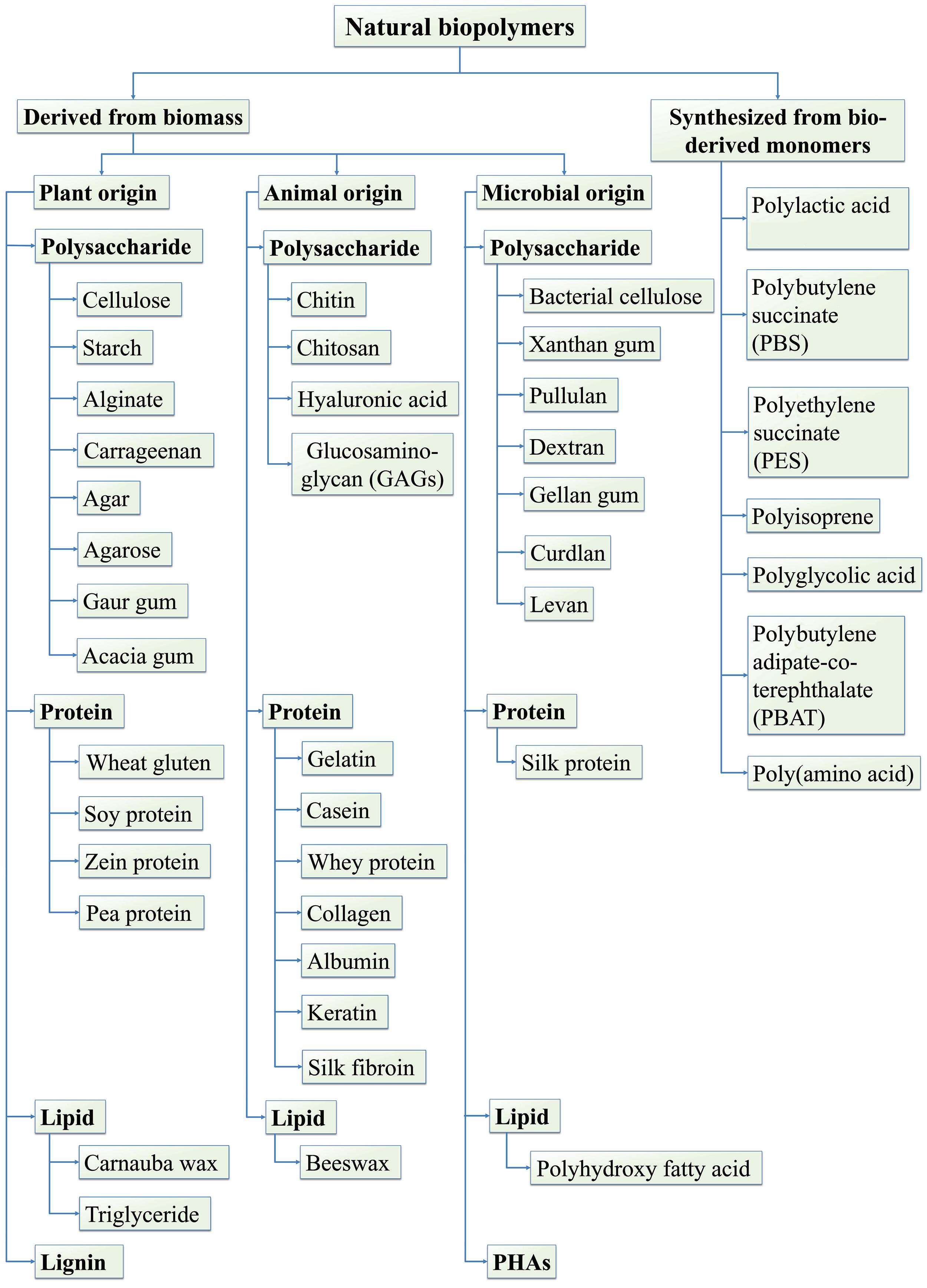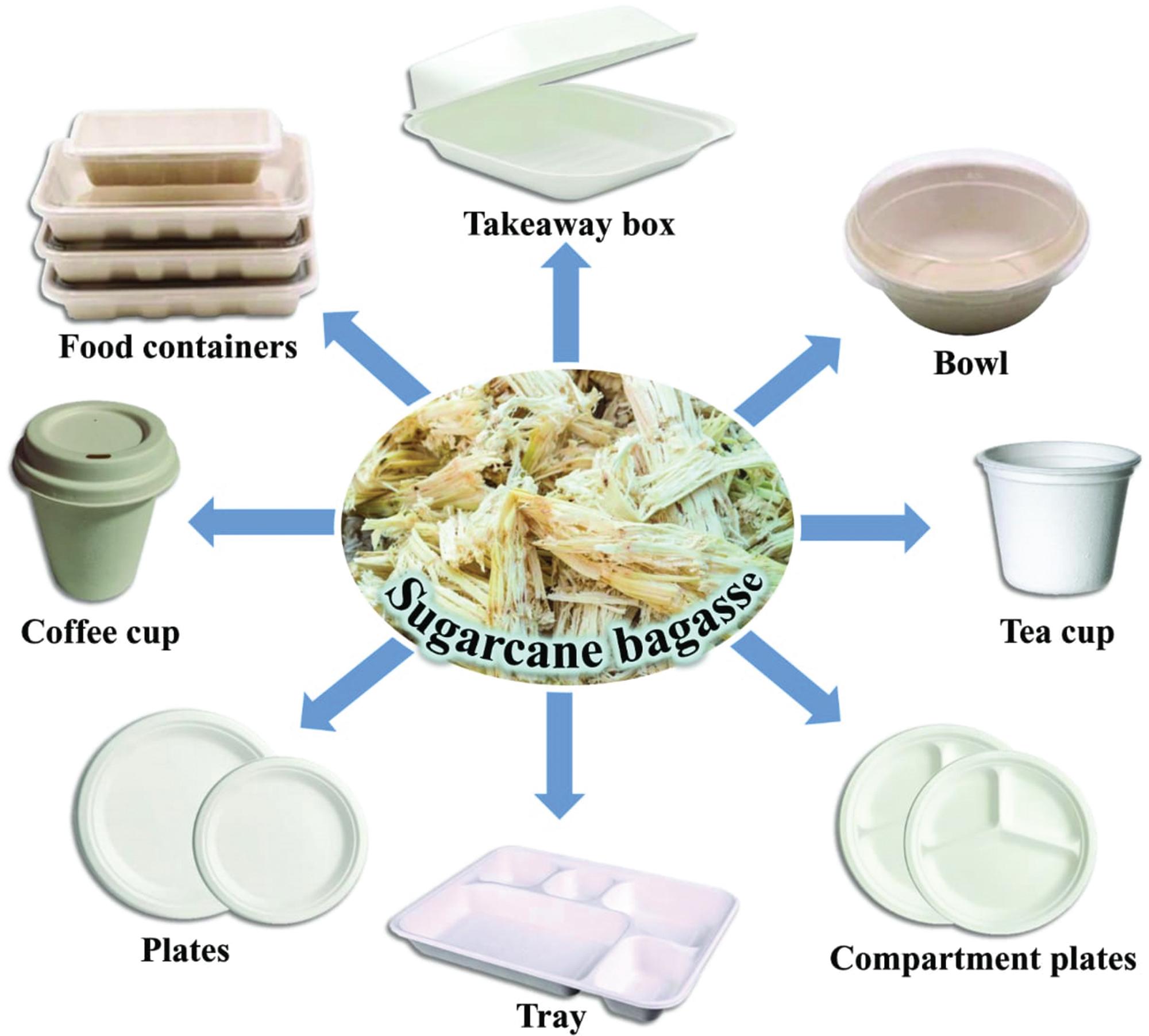Biopolymer-Based Food Packaging: Innovations and Technology Santosh Kumar
Visit to download the full and correct content document: https://ebookmass.com/product/biopolymer-based-food-packaging-innovations-and-te chnology-santosh-kumar/
More products digital (pdf, epub, mobi) instant download maybe you interests ...
Sustainable Food Packaging Technology Athanassia
Athanassiou
https://ebookmass.com/product/sustainable-food-packagingtechnology-athanassia-athanassiou/
Biopolymer-based Formulations: Biomedical and Food Applications 1st Edition Kunal Pal (Editor)
https://ebookmass.com/product/biopolymer-based-formulationsbiomedical-and-food-applications-1st-edition-kunal-pal-editor/
Starch-based materials in food packaging processing, characterization and applications Barbosa
https://ebookmass.com/product/starch-based-materials-in-foodpackaging-processing-characterization-and-applications-barbosa/
Cation Transporters in Plants Santosh Kumar Upadhyay
https://ebookmass.com/product/cation-transporters-in-plantssantosh-kumar-upadhyay/
Nanotechnology-Enhanced Food Packaging Jyotishkumar Parameswaranpillai
https://ebookmass.com/product/nanotechnology-enhanced-foodpackaging-jyotishkumar-parameswaranpillai/
Electronic Packaging Science and Technology King-Ning
Tu
https://ebookmass.com/product/electronic-packaging-science-andtechnology-king-ning-tu/
Biopolymer Nanostructures for Food Encapsulation Purposes Seid Mahdi Jafari
https://ebookmass.com/product/biopolymer-nanostructures-for-foodencapsulation-purposes-seid-mahdi-jafari/
Antimicrobial food packaging 1st Edition Jorge BarrosVelazquez
https://ebookmass.com/product/antimicrobial-food-packaging-1stedition-jorge-barros-velazquez/
Nanotechnology in the Agri-Food Industry: Food Packaging 1st Edition Alexandru Grumezescu
https://ebookmass.com/product/nanotechnology-in-the-agri-foodindustry-food-packaging-1st-edition-alexandru-grumezescu/
Biopolymer-Based Food Packaging: Innovations and Technology Applications
Biopolymer-Based Food Packaging: Innovations and Technology Applications
Edited by
Santosh Kumar
Central Institute of Technology Kokrajhar
Kokrajhar, India
Avik Mukherjee
Central Institute of Technology Kokrajhar
Kokrajhar, India
Joydeep Dutta
KTH Royal Institute of Technology Stockholm, Sweden
This edition first published 2022
© 2022 John Wiley & Sons Ltd
All rights reserved. No part of this publication may be reproduced, stored in a retrieval system, or transmitted, in any form or by any means, electronic, mechanical, photocopying, recording or otherwise, except as permitted by law. Advice on how to obtain permission to reuse material from this title is available at http://www.wiley.com/go/permissions.
The right of Santosh Kumar, Avik Mukherjee, and Joydeep Dutta to be identified as the author(s) of the editorial material in this work has been asserted in accordance with law.
Registered Office(s)
John Wiley & Sons, Inc., 111 River Street, Hoboken, NJ 07030, USA
John Wiley & Sons Ltd, The Atrium, Southern Gate, Chichester, West Sussex, PO19 8SQ, UK
Editorial Office
The Atrium, Southern Gate, Chichester, West Sussex, PO19 8SQ, UK
For details of our global editorial offices, customer services, and more information about Wiley products visit us at www.wiley.com.
Wiley also publishes its books in a variety of electronic formats and by print-on-demand. Some content that appears in standard print versions of this book may not be available in other formats.
Limit of Liability/Disclaimer of Warranty
The contents of this work are intended to further general scientific research, understanding, and discussion only and are not intended and should not be relied upon as recommending or promoting scientific method, diagnosis, or treatment by physicians for any particular patient. In view of ongoing research, equipment modifications, changes in governmental regulations, and the constant flow of information relating to the use of medicines, equipment, and devices, the reader is urged to review and evaluate the information provided in the package insert or instructions for each medicine, equipment, or device for, among other things, any changes in the instructions or indication of usage and for added warnings and precautions. While the publisher and authors have used their best efforts in preparing this work, they make no representations or warranties with respect to the accuracy or completeness of the contents of this work and specifically disclaim all warranties, including without limitation any implied warranties of merchantability or fitness for a particular purpose. No warranty may be created or extended by sales representatives, written sales materials or promotional statements for this work. The fact that an organization, website, or product is referred to in this work as a citation and/or potential source of further information does not mean that the publisher and authors endorse the information or services the organization, website, or product may provide or recommendations it may make. This work is sold with the understanding that the publisher is not engaged in rendering professional services. The advice and strategies contained herein may not be suitable for your situation. You should consult with a specialist where appropriate. Further, readers should be aware that websites listed in this work may have changed or disappeared between when this work was written and when it is read. Neither the publisher nor authors shall be liable for any loss of profit or any other commercial damages, including but not limited to special, incidental, consequential, or other damages.
Library of Congress Cataloging-in-Publication Data
Names: Kumar, Santosh, 1980- editor. | Mukherjee, Avik, editor. | Dutta, Joydeep (Professor of functional materials), editor.
Title: Biopolymer-based food packaging : innovations and technology applications / edited by Santosh Kumar, Avik Mukherjee, Joydeep Dutta.
Description: Hoboken, NJ : John Wiley & Sons, [2022] | Includes bibliographical references and index.
Identifiers: LCCN 2021045228 (print) | LCCN 2021045229 (ebook) | ISBN 9781119702252 (hardback) | ISBN 9781119702320 (pdf) | ISBN 9781119702337 (epub) | ISBN 9781119702313 (ebook)
Subjects: LCSH: Food--Packaging. | Biopolymers.
Classification: LCC TP374 .B575 2022 (print) | LCC TP374 (ebook) | DDC 664/.09--dc23/eng/20211109
LC record available at https://lccn.loc.gov/2021045228
LC ebook record available at https://lccn.loc.gov/2021045229
Cover image: Mike Powles/Getty; BlackJack3D/Getty
Cover design by Wiley
Set in 9.5/12.5pt STIXTwoText by Integra Software Services Pvt. Ltd, Pondicherry, India 10 9 8 7 6 5 4 3 2 1
Contents
List of Contributors xv
Preface xix
1 An Overview of Natural Biopolymers in Food Packaging 1 Santosh Kumar, Indra Bhusan Basumatary, Avik Mukherjee, and Joydeep Dutta
1.1 Introduction 1
1.2 History and Background 4
1.3 Classification 6
1.3.1 Polysaccharide-Based Biopolymers 6
1.3.2 Protein-Based Biopolymers 11
1.3.3 Lipid-Based Biopolymers 13
1.3.4 Biopolymers Synthesized from Bio-derived Monomers 14
1.4 Advantages and Disadvantages 15
1.5 Properties and Applications 16
1.6 Conclusion and Perspectives 17
References 21
2 Biopolymers: The Chemistry of Food and Packaging 29 Rajib Majumder, Arpita Das, Avik Mukherjee, and Santosh Kumar
2.1 Introduction 30
2.2 Biopolymers, Packaging Surfaces, and the Chemistry of Foods 31
2.2.1 Biopolymers 31
2.2.2 Polysaccharide-Based Biopolymers 32
2.2.2.1 Starch and Derivatives 32
2.2.2.2 Cellulose and Derivatives 33
2.2.2.3 Chitin and Derivatives 33
2.2.2.4 Alginate and Pectin 34
2.2.2.5 Xanthan Gum 34
2.2.3 Protein-Based Biopolymers 35
2.2.3.1 Gelatin 35
2.2.3.2 Collagen 35
2.2.3.3 Soy Protein 36
2.2.3.4 Whey Protein 36
2.2.4 Aliphatic Polyester-Based Biopolymers 36
2.3 Properties 37
2.3.1 Physicochemical Properties 37
2.3.1.1 Density 42
2.3.1.2 Crystallinity 42
2.3.1.3 Melting Temperature (Tm) 43
2.3.1.4 Glass Transition Temperature (Tg) 44
2.3.1.5 Film-Forming Property 44
2.3.1.6 Solubility 44
2.3.1.7 Transparency 45
2.3.1.8 Thermal Stability 45
2.3.2 Mechanical Properties 45
2.3.3 Barrier Properties 46
2.3.4 Bio-activities 47
2.3.5 Biodegradability 49
2.4 Interactions Between Food and Packaging 50
2.4.1 Migration 50
2.4.2 Permeation 50
2.4.3 Sorption 51
2.5 Surface Properties of Packages and Food 52
2.5.1 Hydrophilicity and Hydrophobicity 52
2.5.2 Contact Angle 52
2.5.3 Wettability 53
2.6 Conclusion and Future Perspectives 53
References 54
3 Technologies for Biopolymer-Based Films and Coatings 66
Anjali Khuntia, N. Sai Prasanna, and Jayeeta Mitra
3.1 Introduction 67
3.2 Fabrication Techniques for Films 68
3.2.1 Solvent Casting or Wet Process 68
3.2.1.1 Film-Forming Solution (FFS) 69
3.2.1.2 Film Casting or Film Coating 71
3.2.1.3 Film Drying 71
3.2.2 Extrusion or Dry Process 71
3.2.3 Electrohydrodynamic Technique 76
3.2.4 Comparison and Application of Different Fabrication Techniques 76
3.3 Coating Methods 76
3.3.1 Dipping 77
3.3.2 Brushing 77
3.3.3 Spraying 77
3.3.4 Electrospraying 78
3.3.5 Layer-by-Layer (LBL) Electrostatic Deposition 78
3.3.6 Vacuum Impregnation (VI) 79
3.4 Properties 79
3.4.1 Physical Properties 79
3.4.1.1 Thickness 79
3.4.1.2 Density 80
3.4.2 Water Absorption Capacity and Sorption Analysis 80
3.4.3 Contact Angle/Wetting Tension 82
3.4.4 Mechanical Properties 82
3.4.4.1 Tensile 84
3.4.4.2 Puncture Tests 85
3.4.5 Permeability 88
3.4.5.1 Water Vapor Permeability 88
3.4.5.2 Gas Permeability 92
3.4.6 Optical Properties 93
3.4.7 Rheological Properties 93
3.4.7.1 Viscosity Tests 94
3.4.7.2 Melt Index Test 94
3.4.8 Thermal Properties 95
3.4.8.1 Differential Scanning Calorimetry 95
3.4.8.2 Thermogravimetric Analysis 95
3.4.8.3 Thermomechanical Analysis 96
3.4.8.4 Dynamic Mechanical Thermal Analysis 97
3.5 Applications 98
3.5.1 Composite Films or Multilayer Packaging 99
3.5.2 Nanostructured Film 99
3.5.2.1 Nanocomposite Films 99
3.5.2.2 Nanolaminated Films 101
3.6 Conclusion and Perspectives 101
References 101
4 Chitosan-Based Films and Coatings 110
Gitanjali Gautam, Ruchi Rani, Laxmikant S. Badwaik, and Charu Lata Mahanta
4.1 Introduction 110
4.2 Sources, Structure, and Properties 111
4.2.1 Sources 111
4.2.2 Structure 112
4.2.3 Properties 114
4.3 Isolation, Characterization, and Modifications 115
4.3.1 Isolation 115
4.3.1.1 Extraction from Crustaceous Shells 115
4.3.1.2 Extraction from Fungal Cell Wall and Mushrooms 116
4.3.1.3 Extraction from Insect Cuticles 117
4.3.1.4 Extraction from Terrestrial Animal Exoskeletons 118
4.3.2 Characterization 119
4.3.3 Modifications 119
4.4 Chitosan-Based Composite Films and Coatings 123
4.4.1 Gelatin-Based Edible Films and Coatings 123
4.4.2 Protein-Based Edible Films and Coatings 124
4.4.3 Starch-Based Edible Films and Coatings 125
4.4.4 Alginate-Based Edible Films and Coatings 125
4.5 Using Essential Oils as Antimicrobial Agent 126
4.5.1 Rosemary (Rosmarinus officinalis) 127
4.5.2 Cinnamon (Cinnamomum verum) 127
4.5.3 Oregano (Origanum vulgare) 127
4.5.4 Clove (Syzygium aromaticum L.) 128
4.5.5 Thyme (Thymus vulgaris) 128
4.6 Antimicrobial Activities 128
4.7 Effects on the Quality of Fruits and Vegetables 130
4.8 Effects on the Quality of Meat, Fish, and Seafood 130
4.9 Conclusion and Perspectives 137
References 138
5 Starch-Based Edible Films and Coatings 147
Priyadarshini, S.R., Srinivasan Krishnamoorthy, J.A. Moses, and C. Anandharamakrishnan
5.1 Introduction 148
5.2 Source, Structure, and Characteristics of Starch Granules 148
5.3 Physicochemical, Rheological, and Functional Properties 150
5.4 Chemical and Physical Modifications 152
5.4.1 Chemical Modifications 152
5.4.1.1 Crosslinking 152
5.4.1.2 Grafting 153
5.4.1.3 Esterification 153
5.4.1.4 Etherification 153
5.4.1.5 Oxidization 153
5.4.1.6 Cationic Modification 153
5.4.1.7 Dual Modification 154
5.4.2 Physical Modifications 154
5.4.2.1 Pregelatinized Starch 154
5.4.2.2 Annealing 154
5.4.2.3 Heat Moisture Treatment 154
5.4.2.4 Heat Drying 155
5.4.2.5 Osmotic Pressure Treatment 155
5.2.2.6 Freezing 155
5.2.2.7 Thermal Inhibition 155
5.4.2.8 Non-Thermal Modifications 155
5.5 Starch-Based Bionanocomposite Films and Coatings 156
5.6 Characterization 159
5.6.1 Film Thickness 159
5.6.2 Particle Size Determination 159
5.6.3 Scanning Electron Microscopy (SEM) 159
5.6.4 Fourier Transform Infrared Spectroscopy (FTIR) 160
5.6.5 X-ray Diffraction (XRD) 162
5.7 Applications 164
5.8 Recent Developments and Future Directions 168
5.9 Conclusion and Perspectives 169
References 170
6 Protein-Based Films and Coatings 178 Manashi Das Purkayastha and Santosh Kumar
6.1 Introduction 179
6.2 Types, Structures, and Properties 180
6.2.1 Casein 180
6.2.2 Whey 180
6.2.3 Gluten 181
6.2.4 Soy Protein 182
6.2.5 Collagen and Gelatin 182
6.2.6 Zein 183
6.3 Improvement in Physicochemical Properties of Proteins 183
6.3.1 Plasticizers 184
6.3.2 Physical and Chemical Crosslinking 185
6.4 Protein-Based Nanocomposites and Their Various Properties 187
6.5 Fabrication Techniques 192
6.5.1 Direct Casting 192
6.5.2 Coating 192
6.5.3 Spread Coating 193
6.5.4 Spin Coating 194
6.5.5 Spray Coating or Spraying 194
6.5.6 Dip Coating or Immersion Coating 194
6.5.7 Fluidized-Bed Coating 195
6.5.8 Pan Coating or Panning 195
6.5.9 Layer-by-Layer Assembly 195
6.5.10 Electrospinning 196
6.5.11 Extrusion 196
6.5.12 Compression Molding 198
6.5.13 Lamination 199
6.6 Applications 200
6.6.1 As Carrier of Antimicrobial Agents 201
6.6.2 As Carrier of Antioxidants 203
6.6.3 As Carrier of Flavoring Compounds 204
6.6.4 As Carrier of Live Microorganisms 206
6.7 Conclusion and Perspectives 208
References 209
7 Microbial Polysaccharides (MPs) in Food Packaging 225 C. Shashikumar, Sudip Mitra, and Siddhartha Singha
7.1 Introduction 225
Contents x
7.2 Production 227
7.3 Extraction and Purification 230
7.4 Characterization 230
7.4.1 Chemical Structure 234
7.4.2 Physicochemical Properties 239
7.4.2.1 Xanthan 239
7.4.2.2 Scleroglucan 239
7.4.2.3 Hyaluronic Acid or Hyaluronan 239
7.4.2.4 Xylinan or Acetan 239
7.4.2.5 Dextran 240
7.4.2.6 Gellan 241
7.4.2.7 Curdlan 242
7.4.2.8 Bacterial Cellulose 243
7.4.2.9 Pullulan 243
7.4.2.10 Alginate 243
7.4.2.11 Levan 244
7.4.2.12 β-Glucan 244
7.4.2.13 FucoPol 244
7.4.2.14 Kefiran 245
7.4.2.15 Polyhydroxyalkanoate 245
7.4.3 Film Formability and Properties Relevant for Packaging 245
7.5 Strategies for Tailoring MP Structures for Packaging Film or Coat Applications 249
7.6 Applications and Their Commercialization Status 251
7.7 Conclusion and Perspectives 255 References 256
8 Polylactic Acid (PLA)-Based Composites in Food Packaging 264 M. Sukumar, K. Sudharsan, and Radha Krishnan K.
8.1 Introduction 264
8.1.1 Production of Lactic Acid 266
8.1.2 Properties 267
8.1.3 PLA Composites as Food Packaging Materials 269
8.2 Isolation and Purification 272
8.3 PLA-Based Antimicrobial Nanocomposites 274
8.4 Applications 276
8.5 Conclusion and Perspectives 277 References 278
9 Antimicrobial Agents in Films and Coatings 282 Yashaswini Premjit, Gulshan Kumar Malik, and Jayeeta Mitra
9.1 Introduction 283
9.2 Classification 284
9.2.1 Natural Antimicrobials 284
9.2.1.1 Plant-Based Antimicrobials 290
9.2.1.2 Microbial-Based Antimicrobials 291
9.2.1.3 Animal-Based Antimicrobials 292
9.2.2 Chemical Antimicrobials 293
9.2.2.1 Nitrites 293
9.2.2.2 Chlorine Dioxide 293
9.2.3 Antimicrobial Nanostructures 294
9.2.3.1 Nanocarriers for Antimicrobials 294
9.2.3.2 Silver Nanoparticles 294
9.2.3.3 Chitosan Nanostructures 294
9.2.3.4 Nanoclays 294
9.2.3.5 Metal Oxide Nanoparticles 295
9.3 Choice of Materials 295
9.4 Methods of Addition 299
9.4.1 Antimicrobial Edible Coatings 299
9.4.2 Antimicrobial Films 303
9.4.3 Antimicrobial Pads 305
9.4.4 Antimicrobial Sachets 306
9.4.5 Modified Atmospheric Packaging 307
9.5 Effect on Packaging Film Properties 308
9.5.1 Effect on Mechanical Properties 308
9.5.2 Effect on Barrier Properties 310
9.5.3 Effect on Appearance, Color, and Transparency 310
9.5.4 Effect on Surface Hydrophilicity/Hydrophobicity of Films 313
9.6 Mechanisms of Action 313
9.6.1 Essential Oils 313
9.6.2 Organic Acids 314
9.6.3 Animal-Based Antimicrobials 314
9.6.4 Antimicrobial Peptides 315
9.6.5 Antimicrobial Nanoparticles 315
9.6.5.1 TiO2 315
9.6.5.2 ZnO 316
9.6.5.3 Ag NPs 316
9.7 Release Kinetics from Packaging Systems to Food 317
9.8 Food Regulations 319
9.9 Commercialization 320
9.10 Conclusion and Perspectives 320 References 322
10 Nanomaterials in Food Packaging 336 Santosh Kumar, Avik Mukherjee, Sweety Kalita, Namrata Singh, Vimal Katiyar Atanu Mitra, and Dipankar Halder
10.1 Introduction 336
10.2 Nanomaterials and Food Packaging Concepts 337
10.3 Applications 339
10.3.1 Supplementing Packaging Characteristics 339
10.3.1.1 Nanoclay 342
10.3.1.2 Graphene 345
10.3.1.3 Organic Nanofillers 345
10.3.2 Antimicrobial Packaging 346
10.3.3 Extending Shelf-Life of Food 347
10.3.4 Inducing Smartness/Intelligence 351
10.4 Migration to Packaged Food Items 353
10.5 Environmental and Safety Aspects 354
10.5.1 Impact on Human Health and the Environment 354
10.5.2 Regulations on Use in the Food Sector 356
10.6 Conclusion and Perspectives 357
References 358
11 Silver and Zinc Oxide Nanoparticles in Films and Coatings 368
Abhishek Roy, K. Dharmalingam, and R. Anandalakshmi
11.1 Introduction 368
11.2 Antimicrobial Properties 369
11.3 Biopolymer-Based Silver Nanocomposites 375
11.4 ZnO Nanostructures in Biopolymers 377
11.5 Applications of Silver Bionanocomposites 379
11.6 Applications of ZnO Bionanocomposites 383
11.7 Conclusion and Perspectives 384
References 385
12 Plant-Based Active Compounds in Food Packaging 394
N. Arul Manikandan, Kannan Pakshirajan, and G. Pugazhenthi
12.1 Introduction 394
12.2 Plant-Based Active Compounds 396
12.2.1 Simple Phenolic Compounds 396
12.2.2 Flavones, Flavanols, and Flavonoids 396
12.2.3 Quinones 396
12.2.4 Tannins 397
12.2.5 Coumarins 398
12.2.6 Alkaloids 398
12.2.7 Terpenes 398
12.3 Active Components to Control Microbial Spoilage 398
12.3.1 Turmeric 405
12.3.2 Cinnamon 405
12.3.3 Lemongrass 405
12.3.4 Neem 406
12.3.5 Coriander 406
12.3.6 Garlic 406
12.3.7 Rosemary 406
12.3.8 Grapefruit Seed 407
12.3.9 Aloe Vera 407
12.3.10 Oregano 407
12.4 Active Materials to Control Food Oxidation (Food Antioxidants) 408
12.4.1 Quercetin 408
12.4.2 Carnosic Acid 409
12.4.3 Ellagic Acid 410
12.4.4 Ferulic Acid 410
12.4.5 α-Tocopherol 411
12.5 Polymer-Based Composites 411
12.6 Conclusion and Perspectives 415
References 415
13
Essential Oils in Active Films and Coatings 422 K. Dharmalingam, Abhishek Roy, and R. Anandalakshmi
13.1 Introduction 422
13.2 Classifications and Components 423
13.3 Properties and Characteristics 424
13.4 Encapsulation 425
13.5 Biopolymer-Essential Oil Composites 428
13.6 Applications 432
13.7 Conclusion and Perspectives 438
References 439
14 Edible Films and Coatings 445
Indra Bhusan Basumatary, Sweety Kalita, Vimal Katiyar, Avik Mukherjee, and Santosh Kumar
14.1 Introduction 445
14.2 Biopolymers 447
14.2.1 Polysaccharides 447
14.2.2 Proteins 448
14.2.3 Lipids 450
14.3 Natural Active Components 450
14.3.1 Plant Extracts 450
14.3.2 Antimicrobial Peptides 452
14.3.3 Probiotics 453
14.4 Nanomaterials 453
14.4.1 Inorganic Nanomaterials 453
14.4.2 Organic Nanomaterials 455
14.5 Extending Shelf-Life of Food 456
14.5.1 Fruits and Vegetables 456
14.5.2 Meat, Poultry, and Fish 459
14.5.3 Milk and Dairy Products 460
14.6 Conclusion and Perspectives 460
References 465
Index 476
List of Contributors
R. Anandalakshmi
Advance Energy & Materials Systems Laboratory (AEMSL), Department of Chemical Engineering, Indian Institute of Technology Guwahati, Guwahati, Assam, India
C. Anandharamakrishnan
Computational Modeling and Nanoscale
Processing Unit, Indian Institute of Food Processing Technology (IIFPT), Ministry of Food Processing Industries, Government of India, Thanjavur, Tamil Nadu, India
Laxmikant S. Badwaik
Department of Food Engineering and Technology, School of Engineering, Tezpur University, Napaam, Assam, India
Indra Bhusan Basumatary
Department of Food Engineering and Technology, Central Institute of Technology Kokrajhar, Kokrajhar, Assam, India
Arpita Das
School of Life Science and Biotechnology, Adamas University, Barasat, West Bengal, India
K. Dharmalingam
Advance Energy & Materials Systems Laboratory (AEMSL), Department of Chemical Engineering, Indian Institute of Technology Guwahati, Guwahati, Assam, India
Joydeep Dutta
Functional Materials, Department of Applied Physics, SCI School, KTH Royal Institute of Technology, Stockholm, Sweden
Gitanjali Gautam
Department of Food Engineering and Technology, School of Engineering, Tezpur University, Napaam, Assam, India
Dipankar Halder
Department of Food Technology and Biochemical Engineering, Jadavpur University, Kolkata, India
Sweety Kalita
Department of Food Engineering and Technology, Central Institute of Technology Kokrajhar, Kokrajhar, Assam, India
List of Contributors xvi
Vimal Katiyar
Department of Chemical Engineering, Indian Institute of Technology Guwahati, Guwahati, Assam, India
Anjali Khuntia
Agricultural & Food Engineering
Department, Indian Institute of Technology Kharagpur, Kharagpur, India
Srinivasan Krishnamoorthy
Computational Modeling and Nanoscale Processing Unit, Indian Institute of Food Processing Technology (IIFPT), Ministry of Food Processing Industries, Government of India, Thanjavur, Tamil Nadu, India
Santosh Kumar
Department of Food Engineering and Technology, Central Institute of Technology Kokrajhar, Kokrajhar, Assam, India
Charu Lata Mahanta
Department of Food Engineering and Technology, School of Engineering, Tezpur University, Napaam, Assam, India
Rajib Majumder
School of Life Science and Biotechnology, Adamas University, Barasat, West Bengal, India
Gulshan Kumar Malik
Agricultural & Food Engineering Department, Indian Institute of Technology Kharagpur, Kharagpur, India
N. Arul Manikandan
Department of Chemical Engineering, Indian Institute of Technology Guwahati, Guwahati, Assam, India
Atanu Mitra
Department of Chemistry, Sree Chaitanya College, Habra, West Bengal, India
Jayeeta Mitra
Agricultural & Food Engineering Department, Indian Institute of Technology Kharagpur, Kharagpur, India
Sudip Mitra
Centre for Rural Technology, Indian Institute of Technology Guwahati, Guwahati, Assam, India
J.A. Moses
Computational Modeling and Nanoscale Processing Unit, Indian Institute of Food Processing Technology (IIFPT), Ministry of Food Processing Industries, Government of India, Thanjavur, Tamil Nadu, India
Avik Mukherjee
Department of Food Engineering and Technology, Central Institute of Technology Kokrajhar, Kokrajhar, Assam, India
Kannan Pakshirajan
Department of Biosciences and Bioengineering, Indian Institute of Technology Guwahati, Guwahati, Assam, India
N. Sai Prasanna
Agricultural & Food Engineering Department, Indian Institute of Technology Kharagpur, Kharagpur, India
Yashaswini Premjit
Agricultural & Food Engineering Department, Indian Institute of Technology Kharagpur, Kharagpur, India
G. Pugazhenthi
Department of Chemical Engineering, Indian Institute of Technology Guwahati, Guwahati, Assam, India
Manashi Das Purkayastha
Food Technology Programme, Department of Horticulture, Assam Agricultural University, Jorhat, Assam, India
K. Radha Krishnan
Department of Food Engineering and Technology, Central Institute of Technology Kokrajhar, Kokrajhar, Assam, India
Ruchi Rani
Department of Food Engineering and Technology, School of Engineering, Tezpur University, Napaam, Assam, India
Abhishek Roy
Advance Energy & Materials Systems Laboratory (AEMSL), Department of Chemical Engineering, Indian Institute of Technology Guwahati, Assam, India
Priyadarshini S. R.
Computational Modeling and Nanoscale Processing Unit, Indian Institute of Food Processing Technology (IIFPT), Ministry
of Food Processing Industries, Government of India, Thanjavur, Tamil Nadu, India
C. Shashikumar
Centre for Rural Technology, Indian Institute of Technology Guwahati, Guwahati, Assam, India
Namrata Singh
Department of Food Engineering and Technology, Central Institute of Technology Kokrajhar, Kokrajhar, Assam, India
Siddhartha Singha
Centre for Rural Technology, Indian Institute of Technology Guwahati, Guwahati, Assam, India
K. Sudharsan
Centre for Food Technology, Alagappa College of Technology, Anna University, Chennai, India; Department of Microbiology, SRM Arts and Science College, Kattankulathur, Chengalpattu District, Tamil Nadu, India
M. Sukumar
Centre for Food Technology, Alagappa College of Technology, Anna University, Chennai, India
Preface
The idea of compiling a book on “Biopolymer-Based Food Packaging: Innovations and Technology Applications” took seed in early 2019. It stemmed from the awareness and growing interest among consumers and readers working at the interface of food, health, and the environment. From the perspective of growing food needs of an ever-increasing population, mostly in developing countries like India, the urge to develop such a book project in this emerging area was perhaps more compelling for the food manufacturing business. As the world is diligently focusing on developing sustainable alternatives to petroleum-based products, including synthetic plastics-based food packaging, biopolymers are gaining increasing attention as sustainable environmentally friendly alternatives. This book is a complete, systematic, sequential account of the contemporary development in the area of application of biopolymers as emerging alternatives in food packaging applications. It aims to be a unique resource for academic researchers, professionals in food packaging and other related industries, research scholars, graduate students, entrepreneurs, and people related to the area of food preservation and shelf-life, environmental safety, and human health. Also, the book introduces the functionalities and shortcomings of biopolymer-based food packaging materials, their characterization, and benefits in preservation and/or packaging of food products.
This book comprises fourteen chapters, covering, in their purview, different polysaccharide, protein, and microbial polymer-based food packaging films and coatings, including biopolymer-based blends and nanocomposites. The first few chapters introduce biopolymers, their blends and nanocomposites, and their chemistry, as well as providing a general introduction to food packaging applications. Chapters 4–9 describe extensively various biopolymers and their potential applications, including their importance as active and intelligent food packaging systems. Chapters 10 and 11 focus on incorporation of nanomaterials as fillers to improve the physicochemical, mechanical, thermal, barrier, optical, and antimicrobial properties of food packaging nanocomposites. Chapters 12 and 13 detail the use of plant-based bioactive compounds, including essential oils and essential oil-derived compounds in active biopolymer-based edible food packaging. The last chapter of the book, Chapter 14, provides a comprehensive overview of biopolymer-based edible food packagings and their effectiveness in shelf-life extension of perishable food items.
It has been a great pleasure and a privilege to collaborate with the contributing authors, representing almost a dozen academic institutes/universities of international repute in India and abroad. The success of this project depends on potential readers across the entire spectra of food and associated areas in academia, industries, businesses, and government bodies. The readers’ enthusiastic acceptance, appreciation, comments, and critiques will inspire us to venture into more such collaborative efforts in future. We are grateful for the support, cooperation, and understanding of our peers, friends, and families for rendering this daunting task possible. Hopefully through this small effort from our part, and through the efforts of the contributing authors, we will be able to contribute to accelerate further development in sustainable food packaging applications to meet the growing demand for food worldwide.
Santosh Kumar
Avik Mukherjee
Joydeep Dutta
An Overview of Natural Biopolymers in Food Packaging
Santosh Kumar 1,*, Indra Bhusan Basumatary 1, Avik Mukherjee1,*, and Joydeep Dutta2,*
1 Department of Food Engineering and Technology, Central Institute of Technology Kokrajhar, Kokrajhar 783370, Assam, India
2 Functional Materials, Department of Applied Physics, SCI School, KTH Royal Institute of Technology, Hannes Alfvéns väg 12, 114 19, Stockholm, Sweden
* Corresponding authors: Santosh Kumar, s.kumar@cit.ac.in; Avik Mukherjee, ak.mukherjee@cit.ac.in; Joydeep Dutta, joydeep@kth.se
CHAPTER MENU
1.1 Introduction 1
1.2 History and Background 4
1.3 Classification 6
1.3.1 Polysaccharide-Based Biopolymers 6
1.3.2 Protein-Based Biopolymers 11
1.3.3 Lipid-Based Biopolymers 13
1.3.4 Biopolymers Synthesized from Bio-derived Monomers 14
1.4 Advantages and Disadvantages 15
1.5 Properties and Applications 16
1.6 Conclusion and Perspectives 17
1.1 Introduction
The prefix “bio” in the term “biopolymer” signifies that these polymers are of biological origin, i.e. inherently produced in living organisms. Biopolymers, bio-based polymers, biodegradable polymers, and bioplastics are used synonymously in specific contexts, but each term has a different meaning. Bio-based polymers are materials produced from natural resources such as plants, animals, and microorganisms that can be biodegradable (e.g. starch, polylactic acid [PLA]) or non-degradable (e.g. biopolyethylene) [1]. Biodegradable polymers are materials that completely degrade when exposed to soil, air, water, and microorganisms over a specific time period. Biodegradable polymers may be natural (e.g. starch, cellulose, proteins, lipids) or synthetically produced (e.g. polycaprolactone and polybutylene succinate). A bioplastic is a plastic polymer manufactured from a natural or renewable source, and it is biodegradable [2]. Biopolymers are primarily composed of repeating units of monomers made of carbon (C), hydrogen (H), oxygen (O), and nitrogen (N) and are found in living organisms such as plants, animals, and microorganisms. Based on this definition, biopolymers include bio-based polymers and natural polymers, including biodegradable polymers such as polysaccharides, proteins, lipids, and
Biopolymer-Based Food Packaging: Innovations and Technology Applications, First Edition. Edited by Santosh Kumar, Avik Mukherjee, and Joydeep Dutta.
© 2022 John Wiley & Sons Ltd. Published 2022 by John Wiley & Sons Ltd.
polynucleotides (DNA and RNA). However, biopolymers such as DNA and RNA have complex molecular structure, in which monosaccharide, protein/amino acids, and functional groups such as phosphate groups are joined together by complex intramolecular interactions like hydrogen bonding, disulfide bridges, and hydrophobic interactions to create three-dimensional (3D) structure and termed as bio-based heteropolymers or biomacromolecules [3].
The physicochemical properties of biopolymers such as stiffness, elasticity, conductivity of electricity and heat, resistance to corrosion, appearance such as transparency, and color depend on the type(s) of monomer, degree of polymerization, and type(s) of intramolecular bonds. Compared to synthetic polymers obtained from fossil fuels, biopolymers offer the obvious advantage of eco-friendly degradation, which leads to effective waste management and a healthy environment. The biopolymers are excellent candidates for various applications such as food, pharmaceuticals, and cosmetics and in several industries including packaging, agriculture, textiles, and water treatment due to their biocompatibility, non-toxicity, and biodegradability [4–6]. However, impact strength, tensile strength, permeability, and thermal stability of biopolymers are relatively inferior compared to synthetic (i.e. petroleum-based) polymers. Reinforcement of fillers or additives in biopolymers significantly improves the mechanical properties, such as tensile and impact strengths of the resulting composites, and thermal and optical properties [7–9]. Cellulose, chitosan, starch, polyvinyl alcohol (PVA), polylactic acid (PLA), polyglycolic acid (PGA), polycaprolactone (PCL), polyhydroxybutyrate (PHB), polybutylene succinate (PBS), etc. have gained substantial attention as biopolymers in food packaging applications [5, 6, 8]. Synthetic polymers like polyethylene (PE), polypropylene (PP), nylon, polyester (PS), polytetrafluoro-ethylene (PTFE), and epoxy are commonly known as plastic and are derived from petroleum hydrocarbons [10]. These materials are still an integral part of our human life, and they have found their way into our daily routine. The demand for petroleum-based polymers in our commercial world is increasing because of their versatility, high mechanical strength, flexibility, resistivity, transparency, chemical inertness, low mass, and low cost [11]. Moreover, these plastic do not readily react with the product with which they are in contact, and they have excellent resistance to water, gases, temperature, and chemical degradation. Synthetic plastics are made from petroleum hydrocarbon, which is a non-renewable resource, and they emit large quantities of greenhouse gases during production [11]. In addition, burning of plastics can emit toxic chemicals such as dioxins [12]. Plastics that are used for short time periods and single-use plastics should not be made of synthetic plastics due to their low density and slow decomposition. As reported by various environment protection agencies, plastics alone account for more than 25% (by volume) of the total municipal solid waste generated. Synthetic plasticsbased food packages/containers and utensils take many years, sometimes even more than a hundred years, to degrade in the environment (Figure 1.1a), whereas natural biopolymer-based food packages/containers and utensils decompose within a few weeks to a few months (Figure 1.1b). Thus, synthetic plastic-based food packages and containers become a significant problem for the environment and living beings. They impact the quality of air, water, and soil and indirectly plant, animal, and human lives. Accumulation
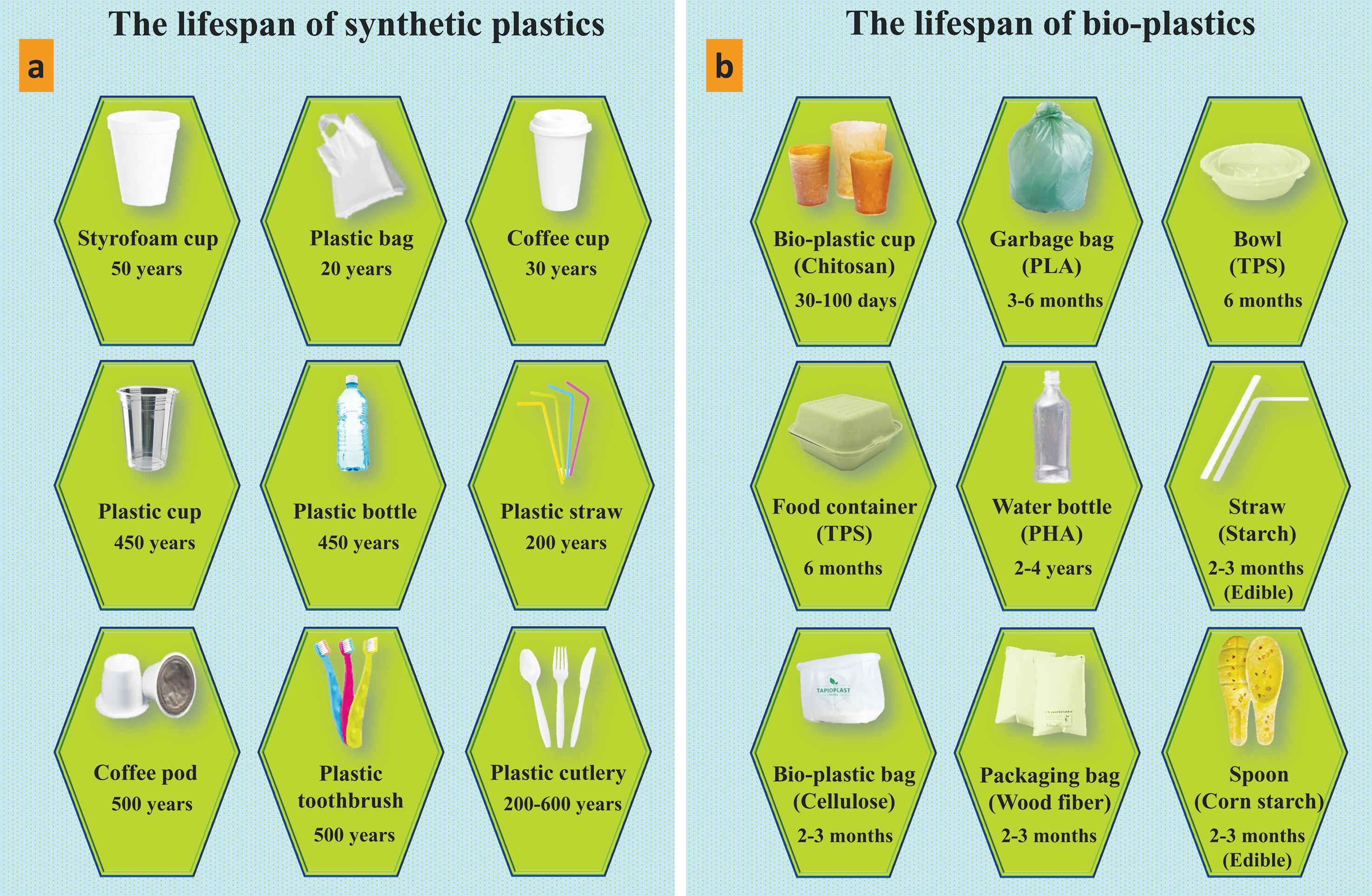
of large amounts of plastic waste in the marine ecosystem causes choking and entanglement of marine flora and fauna [13].
As an alternative to petroleum-based plastics, biopolymers have significant potential to be used in food packaging applications [5, 6]. These would help to reduce the impact of synthetic plastics waste because of rapid degradation of biopolymer-based plastics in the environment. They are decomposed by the enzymatic activity of naturally occurring microorganisms in the environment such as bacteria, fungi, and algae and by chemical processes such as chemical hydrolysis. During biodegradation, biopolymer-based food packages and containers are converted into simple organic molecules, carbon monoxide (CO), methylene (CH), water, biomass, and other natural substances. Biopolymers such as chitosan and PLA are naturally recycled by biological processes (Figure 1.2). Thus, biopolymers are characterized by easy disposal, recycling, biodegradation, and composting and by their eco-friendly nature. In addition, some of them have advantageous features such as inherent antimicrobial and antioxidant activities, because of the presence of different functional groups in their polymeric chains. Despite these advantages, biopolymers lack adequate mechanical and barrier properties, which makes them unsuitable for use as food packaging [14]. Many researchers have focused on this and propose the use of crosslinkers such as nanofillers and blending of two or more biopolymers to address these challenges. This chapter provides a comprehensive overview of various biopolymers and their properties and applications in food packaging and preservation.
Figure 1.1 Lifecycle of (a) synthetic plastics-based food packages/containers and (b) biopolymer-based food packages/containers and utensils.
1.2 History and Background
“Biopolymers” can be defined as polymers that are naturally produced or are obtained from living organisms. The repeating monomer units of biopolymers are saccharides, nucleic acids, or amino acids, and sometimes various additional chemical side chains and functional groups. Historically, biopolymers have been commonly used as food, for making clothes and houses, and as fuel for cooking. They are biodegradable in nature and are obtained from natural renewable resources, which has inspired a renaissance of research interest. Biopolymer-based composite materials are sustainable and have the potential to replace the fossil fuel-based synthetic plastics that have been used on a large scale since the industrial revolution. Fossil fuels are limited resources, and due to non-biodegradability they cause significant environmental problems. Therefore, biopolymers can be used as sustainable and environmentally friendly alternatives to synthetic plastic for food packaging applications.
Silk is an ancient protein polymer, with an amino acid composition that depends on the producing species. Silks are produced by spiders, silkworms, and several lepidoptera larvae. Bombyx mori, a silkworm, is the most popular species for silk production. This silk is characterized by fibroin fibers held together by a glue-like protein called sericin, which is absent in spider silk. Silk fibers have high toughness, good strength, and high elasticity. These properties, including resistance to failure under compression, make silk an attractive material for food packaging applications. In a study, silk fibroin was used to develop a coating formulation (Figure 1.3a) for postharvest shelf-life extension of fruits such as strawberry (Figure 1.3b) and banana (Figure 1.3c) [15]. Researchers reported reduction in oxygen diffusion through silk fibroin thin films/coatings due to increased beta-sheet content. The fruits treated with water-based silk fibroin edible coatings had enhanced postharvest shelf-life at ambient conditions by reducing the rate of cell respiration and transpiration.
Figure 1.2 Lifecycle of chitosan (left) and PLA (right).
Figure 1.3 (a) Dip-coating application of silk fibroin coating formulation on freshly picked strawberries. (b) Images of coated strawberries: (i) no coating (freshly picked), (ii) coated with silk fibroin edible coating (23% beta-sheet, i.e. no water annealing applied), and (iii) coated with silk fibroin (58% beta-sheet, i.e. exposed to water annealing post-processing). (c) Time lapse photography of silk fibroin coated banana stored at 22°C and 38% relative humidity (RH), indicating that silk fibroin coating decreased the ripening rate [15]. (Source: (a) [15], Figure 01A, p 04, CC by 4.0 licence/with permission from Springer Nature. (b) [15], Figure 04, p 08 CC by 4.0 licence/ with permission from Springer Nature.)
In the nineteenth century, another natural polymer, cellulose, started impacting everyday life. Cellulose was also known as Celluloid, Parkesine, Xylonite, and Ivoride, and it was invented by Christian Schönbein (a Swiss professor), Alexander Parkes (an English inventor), and John Wesley Hyatt (an American entrepreneur). In 1847, Parkes started working on cellulose, and he developed the formulas and processes to manufacture cellulose nitrate after spending the next 15 years in the laboratory.
Milk casein has been used as a dietary source of protein since the domestication of livestock. The technologies for making plastics from casein were first patented in 1885 and 1886, in Germany and the USA, respectively [16]. However, the patented material easily biodegraded, and no useful products could be made due to lack of hardening agent in the patented protocol. Clearly, easy biodegradation was a disadvantage or non-desirable a century ago, but today biodegradability is one of the most desirable properties for sustainable packaging.
Day 9
Silk fibroin coating
fibroin coating
1.3 Classification
Biopolymers can be grouped into two broad categories depending on the process of obtaining them: polymers derived from biomass and polymers synthesized from monomers (obtained from biomass) (Figure 1.4). Biomass-derived polymers include polysaccharide, protein, lipid, peptide, polyhydroxyalkanoate (PHA), and gum that are directly obtained from plants, animals, and microorganisms either by fermentation or by chemical method. PHA, cellulose, xanthan, silk, etc. are obtained from carbohydrates – an example of the fermentation approach – whereas chitosan obtained from shrimp and crab shells is an example of a chemical extraction process [17]. The other group of polymers such as PLA, PBS, polyisoprene, polyglycolide, polybutylene adipate-co-terephthalate (PBAT), poly-γ-glutamic acid, poly-ε-L-lysine, and polyaspartic acid, are synthesized by chemical polymerization or by condensation of monomer substrates that are obtained from renewable bio-based material or biomass [17].
1.3.1 Polysaccharide-Based Biopolymers
Polysaccharides are abundantly available and the most exploited family of macromolecules found in living organisms. Polysaccharides are high molecular weight polymers or copolymers of repeating monosaccharide units joined together by glycosidic bonds. In living systems, polysaccharides can be found as a structural material (e.g. cellulose), energy storage material (starch in plants and glycogen in animals), and nutritionally important components (glucose, fructose, etc.). Polysaccharides can be extracted or synthesized from abundantly available natural resources such as plants (cellulose, starch, pectin, and agar), microorganisms (bacterial cellulose, dextran, xanthan, gellan gum, pullulan, and curdlan), animals (chitin/chitosan, chondroitin sulfate, glycosaminoglycans, heparin, and hyaluronan), and algae (alginate, agarose, carrageenan, fucoidan, and ulvan) [9, 18–20].
Among plant-based biopolymers, cellulose is the most abundant, and it is also obtained from some microorganisms. Cellulose has been extensively studied for its application in food packaging and preservation. It is a high-molecular-weight, semicrystalline homopolymer of β-D-glucopyranose units linked by β-1,4 linkage, in which the repeating unit is cellobiose, a dimer of glucose [21]. Cellulose is mainly obtained from plant resources such as cotton, wood, cereal straw, and sugarcane bagasse. It is highly crystalline, which means it is insoluble in most of the solvents. To make cellulose processable, it is modified to its derivatives, such as cellophane, rayon, cellulose acetate, and cellulose ether. Sugarcane bagasse fiber is biodegradable and degrades in landfill within 45 days. It is used to manufacture food packaging materials and disposable utensils such as films, plates, cups, compartment boxes, and other containers (Figure 1.5) [21]. Food industry wastes such as cocoa pod husk (waste from the chocolate industry) and sugarcane bagasse (waste from the sugar industry) were used to develop cellulose-based food packaging films with different ratios of fiber added: 100:0 (100% cellulose), 75:25 (cellulose:fiber), 50:50 (cellulose:fiber), 25:75 (cellulose:fiber), and 0:100 (100% fiber) [22]. These researchers reported that the film having a combination of 75% cellulose and 25% fiber showed the
1.3 Classification 7
lowest water absorption percentage and water vapor permeability, and thus it was most suitable for food packaging applications.
Chitin is the most abundantly available natural biopolymer after cellulose and primarily extracted from the exoskeleton of crustaceans such as shrimps, lobsters, and crabs, insects, and some fungi [23]. Chitin is a heteropolymer consisting of β-1,4-linked 2-acetamide-2-deoxy-D-glucopyranose (N-acetyl-D-glucosamine) and 2-amino-2-deoxy-Dglucopyranose [5, 7]. Chitin and chitosan and their derivatives have the added advantage
Figure 1.4 Classification of biopolymers.
Figure 1.5 Sugarcane bagasse fiber-based food containers and utensils.
of being natural antioxidants with antimicrobial activities, making them functionally attractive choices for fabrication of films and coatings for food packaging [8, 24]. Chitosan is a soluble form of chitin that is obtained by partial deacetylation of chitin. Chitosan has been used in various industrial applications including food preservation and packaging. Chitosan has been recognized and approved as a generally recognized as safe (GRAS) material by the US Food and Drug Administration (FDA), and the European Union (EU) Commission [25]. Chemical and enzymatic modifications of chitosan are performed to enhance its physicochemical and functional properties [25]. These functionalized chitosans with improved properties have wider applications in fabrication of films and coatings for food packaging [5]. Costa et al. fabricated chitosan and cellulose nanocrystal (CNC)-based film by solvent casting and used this as active packaging pads to prolong the shelf-life of chicken meat. They reported that the incorporation of CNC improved thermal stability, mechanical strength, and the gas barrier. In addition, these films showed bactericidal and fungicidal activities against Pseudomonas, Enterobacteriaceae, and Candida albicans [26]. Chitosan-based nanocomposite films containing zinc oxide (ZnO) NPs and gallic acid were evaluated for active food packaging application. The developed chitosan composite films showed improved mechanical properties, oxygen and water vapor permeability (WVP), and ultraviolet-visible (UV-vis) light transmittance [23]. Similarly, green synthesized ZnO NPs and silver (Ag) NPs were used to develop a chitosan-gelatinblended nanocomposite film for postharvest shelf-life extension of grapes, which showed good antimicrobial activity against both Gram-negative (Escherichia coli) and Grampositive (Staphylococcus aureus) bacteria. Additionally, ZnO NP or Ag NP incorporation led to improved thermal stability, elongation-at-break (EAB), and compactness of the nanocomposite films [7, 8].
1.3 Classification 9
Starch is made of amylose, a linear polymer and amylopectin having a highly branched structure. Both amylose and amylopectin consist of large numbers of D-glucose units linked by α-1,4 and α-1,6 glycosidic bonds, respectively. Starch is mainly obtained from rice, wheat, maize, potato, and cassava, and it has various applications in the food industry due to its abundant availability, biodegradability, and edible nature. Starch-based biocomposites are widely used in the fabrication of food packaging films and edible coatings. Starch does not have inherent antioxidant and antimicrobial properties, but it is often used as a carrier for antimicrobial and antioxidant agents. Starch-based packaging films lack mechanical strength, which makes them brittle. To overcome this shortcoming, starch is blended with other biopolymers and nanomaterials, chemically modified, or plasticized, or subjected to a combination of these treatments. Glycerol, polyethers, and urea are commonly used plasticizers in starch-based films and coatings. Starch-based films reinforced with cellulose fibers with added citric acid and phenolic extract of sunflower hull were developed to improve film integrity and antioxidant properties, respectively. The incorporation of citric acid improved crosslinking and mechanical strength, whereas addition of phenolic extract of sunflower hull enhanced antioxidant properties [27]. Jha developed corn starch, chitosan, and nanoclay (sodium montmorillonite [Na-MMT])-based bionanocomposite films containing antimicrobial agents (potassium sorbate [KS]/grapefruit seed extract [GSE]) and reported that the composite films have higher crystallinity, tensile strength, thermal stability, and water vapor barrier properties. Compared to synthetic plastic film, bread samples wrapped in the developed composite film showed high antifungal activity against Aspergillus niger and maintained the quality of the bread for longer duration when stored at 25°C and 59% RH [28].
Algal polysaccharides, mainly alginate and carrageenan, are gaining popularity in food packaging application due to their biodegradability, low cost, biocompatibility, nontoxicity, and other inherent functional properties such as antimicrobial and antioxidant activities. Alginate is mainly found as calcium, magnesium, and sodium salts of alginic acid in brown algae (between 30 and 60%, on the basis of dry weight). Alginate is a binary copolymer of β-D-mannuronic acid monomer and α-L-guluronic acid monomer which are linked through 1,4-glycoside linkage [29]. Carrageenan is a linear heteropolysaccharide composed of carrabioses and carrabiitols and is obtained from red seaweeds such as Eucheuma spp., Kappaphycus spp., Chondrus crispus, and Gigartina stellate [30, 31]. It exists in three forms: κ-, ι-, and λ-carrageenan, based on different structures of the disaccharide (Figure 1.6). κ-carrageenan is the most commonly used in the food packaging industry to fabricate edible films and coatings. Sedayu et al. fabricated semirefined carrageenan films plasticized with glycerol by the solution casting method [32]. The plasticizer improved the tensile strength, thermal stability, optical properties, and water vapor barrier properties of the carrageenan film [32]. Recently, two bioactive compounds, shikonin (extracted from gromwell roots) and propolis (extracted from beeswax), were incorporated into gelatin- and carrageenan-based food packaging films [33]. Shikonin changes color from violet to blue with changes in pH (within the pH range of 2–12), making it an intelligent/smart primary packaging film indicating freshness of packaged fluid milk to consumers. Propolis enhanced functionalities such as antibacterial, antioxidant, antifungal, and antiviral activities of the composite biopolymer packaging film [33]. Another study reported that κ-carrageenan bionanocomposite films added with carbon
Figure 1.6 κ-, ι-, and λ-carrageenan.
–carrageenan
–carrageenan
nanocrystals had improved mechanical, barrier (against moisture and UV light), and thermal stability compared to the pristine κ-carrageenan control film [34].
Microbial biopolymers primarily include exopolysaccharides (EPSs) such as gellan gum, curdlan, pullulan, dextran, xanthan, and kefiran, and are used in the fabrication of films and coatings for food packaging and preservation applications [35]. Gellan gum is an anionic water-soluble EPS, which is industrially produced by the bacterium Sphingomonas elodea. It is commonly used as a food additive as a gelling, thickening, and stabilizing agent mainly for dairy products and confectioneries. In some studies, gellan gum has also been used for fabrication of films and coatings due to its effective barrier properties [35, 36]. Curdlan is a linear water-insoluble EPS produced by bacteria such as Alcaligenes faecalis and Agrobacterium spp. In the food packaging industry, it has attracted much attention as a biopolymer due to its excellent film-forming ability, non-toxicity, and
1.3 Classification 11 biodegradability [37]. Due to its water insolubility and heat-gelling properties, curdlan has the ability to enhance the thermal stability and water barrier properties of food packaging films and coatings. Pullulan is a non-ionic EPS extracted from Aureobasidium pullulans, a yeast-like fungus [38, 39]. It is a biodegradable, flexible, transparent, heat-sealable polymer having good barrier properties as well as antifungal and antioxidant activities. It has been blended with other biopolymers like chitosan, starch, alginate, and pectin to improve the mechanical, thermal, and barrier properties of the blended films [38, 39]. It is mainly used for the preparation of coating formulations for extending postharvest life of fresh fruits and vegetables, as it results in lower oxygen (O2) and higher carbon dioxide (CO2) concentrations in the surrounding atmosphere of the coated fruits and vegetables. Xanthan gum is the first microbial polysaccharide produced by culture fermentation using Xanthomonas campestris. Like pullulan, xanthan is used in blends in other biopolymers for food packaging applications because of its ability to control viscosity [40]. However, the high production cost of xanthan is a major challenge for its large-scale commercial application in the food industry.
1.3.2 Protein-Based Biopolymers
Protein is a heterogeneous polymer made of amino acids joined together by an amide linkage. The number of amino acid residues in the polypeptide chain and their position along the chain determine the protein’s physical and chemical properties. Proteins are relatively abundant and have good film-forming ability, and many of them (with a relatively short chain, e.g. 2–20 amino acids) are bioactive peptides having antioxidant and antimicrobial properties [41]. Thus, many plant- and animal-derived proteins have increasingly become popular choices for fabrication of films and coatings, including edible films and coatings, for food packaging applications [41]. Among plant proteins, gluten, zein, and soy protein, and among animal proteins, gelatin, casein, and whey protein are commonly used as biopolymers for food packaging applications [42–46].
Gluten is the primary storage protein in wheat, which can be classified into glutenin (40–50% of gluten) and gliadin (50–60% of gluten) based on the difference in solubility in aqueous alcohols, the former being soluble and the latter insoluble [41]. Wheat gluten is one of the most abundant plant proteins, and the biopolymer is an attractive choice for fabricating food packaging films and coatings due to its low cost, good tensile strength, viscoelasticity, and excellent gas barrier properties [47, 48]. Disulfide bonds, hydrogen bonds, and hydrophobic interactions primarily contribute to the mechanical strength of gluten-based biopolymer film. Hydrophobic, non-polar fillers like mineral oil improve the barrier properties of gluten films against moisture, whereas heat treatment of the casting film leads to covalent crosslinking within gliadin polypeptide chains, resulting in improved mechanical strength of the film [47]. Gluten-based edible films incorporated with pomegranate peel and curry leaf extracts were fabricated and applied on cherry tomatoes and mangoes for extension of their postharvest shelf-life [49]. The fabricated films showed good structural stability and antimicrobial activity and also extended the shelf-life of wrapped fruits. Sartori et al. developed blend films by blending pectin and gluten and reported improved tensile strength and water vapor and UV-light barrier properties [48].
Zein protein (ZP) is one of the major by-products of corn processing such as dry or wet milling, and it constitutes about 45–50% of the total corn proteins. Due to an abundance of hydrophobic amino acid residues in its structure, zein is insoluble in water and soluble in organic solvents such as ethanol and acetone [21, 41]. Although zein forms biopolymer films with good moisture barrier property, its films are brittle, and polyols or fatty acids are common plasticizers used in the solvent (ethanol or ethanol solution)/wet process of fabrication to improve the mechanical properties of the films. Due to its exceptional filmforming property, zein, either neat or blended with other biopolymer(s), is one of the most commonly used biopolymer proteins for fabrication of food packaging films and coatings [43]. ZP films incorporated with core-shell NPs (TiO2 as core and silica as shell) were prepared by the solution-casting method, and the film containing 1.5% w/w core-shell NPs showed improved mechanical properties, increased hydrophobicity, and enhanced water vapor barrier property [50]. Cui et al. prepared active bionanocomposite film from zein impregnated with chitosan-encapsulated pomegranate peel extract for packaging/wrapping of pork [51]. The bionanocomposite film had thermal stability and showed antimicrobial activity against Listeria monocytogenes inoculated in pork during refrigerated storage. In addition, plasma-treated nanocomposite active film showed a slow release of pomegranate peel extract into the pork sample due to encapsulation in chitosan and ensured longer shelf-life of pork meat [51]. Similarly, a functional edible antioxidant film was developed using curcumin-loaded sodium caseinate and zein, and the composite film showed increased tensile strength (from 3.12 to 7.85 MPa) and water vapor barrier property (from 0.87 to 3.56 × 10−10 g Pa–1 m–1 s–1) [43].
Other than casein, whey protein (WP) is also obtained from milk, and it is a by-product of the milk processing industry. Many researchers have studied whey protein-based films and coatings for food packaging and preservation applications. WP-based films showed good oxygen barrier properties, but, like many other protein-based films, WP-based films have relatively poor WVP [52]. To address these shortcomings, reinforcement of fillers including nanofillers has been extensively used in WP-based films. Xylo-oligosaccharide and galacto-oligosaccharide fillers were incorporated into WP films, resulting in lower WVP (1.09–0.63 g mm h 1 m−2 kPa−1, p < 0.05) and higher hydrophobicity (56.61–46.69°, p < 0.05), as evidenced by contact angle measurement [53]. Alizadeh-Sani et al. reported that cellulose nanofiber (CNF) incorporation in whey protein isolate bionanocomposite film also reduced WVP [54]. In addition, CNFs (7.5%) and titanium dioxide (TiO2) (1%) fillers significantly improved tensile strength and Young’s modulus (YM) of the whey nanocomposite films. Whey protein concentrate (WPC) films added with a blend of three essential oils (EOs) were developed, and the EOs improved the antioxidant property of the composite films, which led to longer shelf-life of packaged salami [46].
Soybeans consist of about 38% protein that is composed of glycinin and conglycinin, and they are obtained from soy flour, soy milk, or fractionated/concentrated forms such as soy protein isolate (SPI)/soy protein concentrate (SPC). Soy protein not only has excellent film-forming property but also has functionalities such as adhesiveness, cohesiveness, emulsifying ability, water and fat absorption, fiber formation, and texturizing capacity [41]. Heating, extrusion, spinning, casting, and thermal compacting are common processes used for fabrication of soy protein films. Addition of fillers such as sodium dodecyl sulfate (SDS) and cysteine improves the moisture barrier properties and tensile
